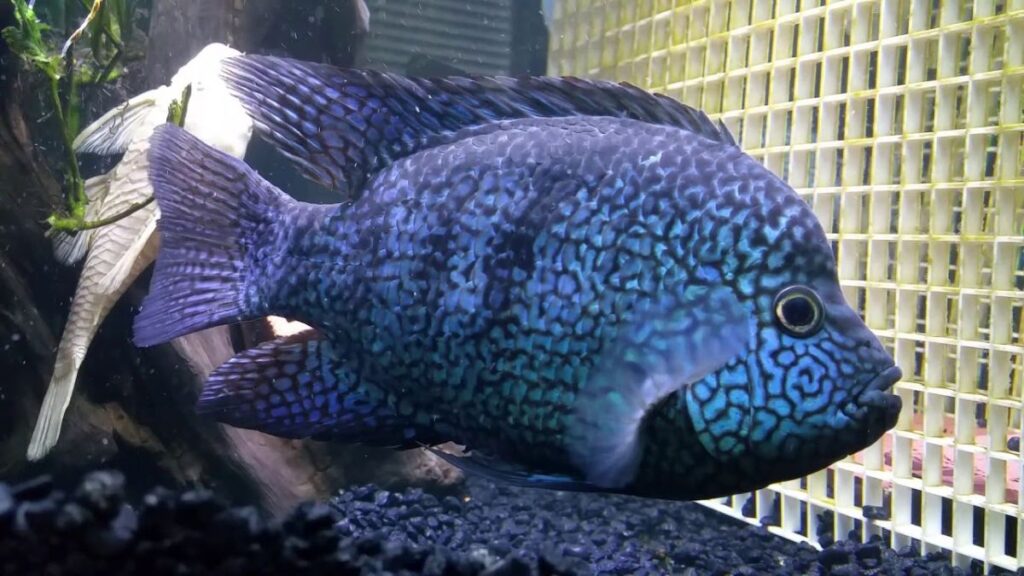The Texas cichlid, also known as the Rio Grande cichlid or the Texas convict fish, is a popular freshwater fish species among aquarists. It is a robust and hardy fish that can thrive in a wide range of water conditions. The Texas cichlid is native to the Rio Grande and other river systems in Texas and Mexico. In this article, we will explore the fascinating world of the Texas cichlid, its natural habitat, physical characteristics, behavior, and care requirements.
Natural Habitat
The Texas cichlid is native to the Rio Grande, which is a river that runs through the southern United States and Mexico. It can also be found in other river systems in Texas, such as the Pecos River and the Nueces River. The Texas cichlid prefers slow-moving water with a sandy or rocky substrate and plenty of hiding places. It can also tolerate brackish water conditions, which is why it is sometimes found in estuaries and coastal marshes.
Physical Characteristics
The Texas cichlid is a large and colorful fish that can grow up to 12 inches in length. Its body is oval-shaped, and it has a pointed head with a large mouth that can extend to the middle of the eye. Its eyes are large and dark, and it has a single dorsal fin that is tall and pointed. The Texas cichlid is usually brown or gray in color, but it can also have blue or green iridescence on its scales. Its fins are edged in white, and it has a black spot on its gill cover.
Behavior
The Texas cichlid is a territorial and aggressive fish that should be kept in a large aquarium with plenty of hiding places. It is best kept in a species-only tank, as it may attack and kill smaller fish. The Texas cichlid is a carnivorous fish that feeds on a variety of foods, including insects, crustaceans, and small fish. In the aquarium, it can be fed a diet of pellets, flakes, and frozen or live foods such as brine shrimp or bloodworms.
Breeding
The Texas cichlid is a sexually dimorphic fish, which means that males and females have different physical characteristics. Males are larger and more colorful than females, and they have longer, pointed dorsal fins. Breeding the Texas cichlid is relatively easy, as it is a prolific breeder. To breed Texas cichlids, you will need a large aquarium with plenty of hiding places and a flat surface for the female to lay her eggs. The male will clean the breeding site and defend it against other fish while the female lays her eggs. After the eggs are laid, the male will fertilize them, and both parents will guard the eggs until they hatch. The fry will hatch after 3-4 days and can be fed brine shrimp or crushed flakes.
Care Requirements
The Texas cichlid is a hardy and adaptable fish that can thrive in a wide range of water conditions. It prefers a water temperature of 72-82°F and a pH range of 6.5-8.0. The water should be kept clean and well-aerated, and regular water changes should be performed to maintain water quality. The Texas cichlid is a messy eater, so uneaten food should be removed from the tank to prevent water pollution. The Texas cichlid is a hardy fish that can live for up to 10 years in captivity with proper care.
Conclusion
The Texas cichlid is a popular and fascinating freshwater fish that can make a great addition to any aquarium. It is a hardy and adaptable fish that can thrive in a wide range of water conditions, and it is relatively easy to breed. However, it is important to keep in mind that the Texas cichlid is an aggressive and territorial fish that should only be kept with other larger and similarly aggressive fish, or in a species-only tank. It is also important to provide plenty of hiding places and a large enough tank to allow for territorial behavior.
If you are interested in keeping Texas cichlids, it is important to do your research and understand their care requirements before bringing them home. You will need to provide a large enough tank, appropriate water conditions, and a varied diet. It is also important to monitor the behavior of your Texas cichlids and make sure that they are not attacking or killing other fish in the tank.







![]()
